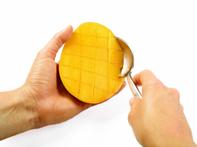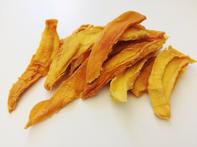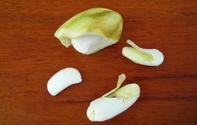The South African mango crop is mainly processed into dried mangos, atchar, and juice. It is also sold fresh as exports and through national fresh produce markets.

Other uses of mangoes include consumption as frozen mango pieces and as dried fruit - sliced or in fruit rolls. Mangoes are also processed into juices, purees, chutneys, canned fruit and pickles, and are used in confectionery and bakery products as well as in ice cream and sorbets.
Other parts of the mango tree such as mango bark, leaves and flowers and roots are used in Ayurvedic medicine. For example, mango flowers boiled in water are used for eczema and mango leaves pulped along with black pepper treat stomach aches and diarrhoea.
Mango Products

Fresh mangos - either green or ripened fruit - can be enjoyed with salt, lime juice or chilli powder, in salsas, salads and is often combined with pork, fish and chicken.
Dried mangos are made from ripened mango. The fruit is washed, skinned, cut into slivers and dried. No sugar is added, but sulphur dioxide may be added as a preservative. Dried mango rolls are made with mango pulp that is thinly spread and dried.
For mango atchar, chunks of green mangoes are mixed with chillies, masala spice, garlic, mustard seeds and oil. This is then left to marinade before bottling and mango chutney is made by boiling mango, sugar, vinegar and spices to a thick jam-like consistency.
Mango flour is made from the ground peels and pips and can be a gluten-free substitute for 10 - 50% of wheat flour in baking. Mango powder also called amchoor. It is made from dried unripe mangoes and is used as a fruity spice.
Mango Juice
Mango varieties too fibrous or too soft for fresh eating can be used for mango juice. Mango juice is made with mango pulp. The ripe fruit is pulped to extract the juice and is then filtered to remove the large pieces. Filtered water, other fruit juice from concentrates, vitamins and natural flavour can be added.
Aseptically packed mango juice is pasteurised and has a shelf life of up to 12 months, but heat-sensitive nutrients such as vitamin C and the B vitamins may be partially destroyed during the pasteurisation process.
The South African Fruit Juice Association recommends states that preservatives may be added to chilled juice to extend the shelflife up to three months, but freshly squeezed juice (with no added preservatives) must ideally be consumed within two hours.
Organic juice is prepared from fruit grown without the use of pesticides and may not be derived from genetically modified crops.
Mango Pits

Mango pips, also known as gutli, can be used for a variety of medicinal and cosmetic purposes including as an oil-rich moisturiser for skin and hair.
It is rich in vitamins (especially B12), minerals such as potassium, calcium, magnesium, iron, zinc, manganese, phosphorus, and it contains 9 out of 10 essential amino acids. The mango kernel (inside the pip) also contains mangiferin which is used to control blood sugar levels.
The pips of young unripe mangoes are the best to use as it can be ground to a pulp or butter. The pips of ripe mangoes are very hard and are only used in powdered form.
Mix the powder or pulp with coconut or olive oil, potentize it in the sun for a few days and use on hair for shine or to treat dandruff and early greying. The powdered form can be mixed with honey to treat diarrhoea and is said to lower blood sugar levels.
Unripe pips are also used in Indian cooking. For example, the outer hairy shell is removed, the kernel cooked and then sliced into slivers, fried and sprinkled with black salt.
Mangoes for Animal Feed
Mango pips and kernels can be used for animal feed. Pips and kernels are soaked and dried (to 10% moisture) to remove tannins before being fed to livestock.
In a Nigerian study, boiled mango kernel meal was extracted from the mango seed. The seed was cut open, kernels extracted, boiled for 30 minutes to remove tannins and sundried before being ground up and combined in a feed for chickens. The study proved that up to 60% of maize meal can be replaced with boiled mango kernel meal in the finisher diet for chickens.
Replacing the maize meal had no adverse effects on growth and meat quality. Daily feed intake and feed conversion ratio were significantly higher with mango kernel meal. In addition, mango kernel meal has a higher fat content compared to maize meal.
Mango Oil
The mango kernel (inside the seed) contains 7 - 12% of oil, which is rich in stearic and oleic acids. Olein (from oleic acid) has emollient properties and stearin (from stearic acid) can replace cocoa butter in chocolate.
Please note:
Information is for educational and informational purposes only and may not be construed as medical advice. The information is not intended to replace medical advice or treatment offered by healthcare professionals.
By Marinda Louw